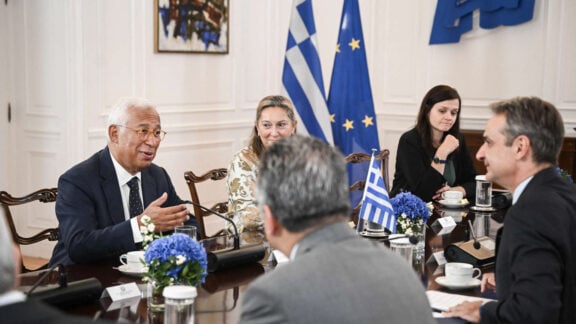The Parthenon of Books is the brainchild of Argentine conceptual and psychedelic artist Marta Minujín, who is in the process of collecting over 100,000 currently or once- banned books for an artistic installation in which she is planning to reconstruct the classical Greek temple of the Parthenon, (Acropolis, Athens), as part of documenta 14, an art event that will take place concurrently in Athens (Greece) and Kassel (Germany) later this year.
The artist began preparing for the construction work at the end of October 2016 on Friedrichsplatz Square in Kassel, where in 1933 the Nazis burned an estimated 2,000 books (May 19, 1933), during the so-called ‘Aktion wider den undeutschen Geist’ (Campaign against the Un-German Spirit).
The graceful Parthenon temple, an eternal symbol of architectural beauty, freedom and democracy, will be used to draw attention to the issues of censorship and persecution. Therefore, Minujín is looking for books which are or have been prohibited and which attempt to influence people’s thoughts, ideas or political views.
The temple will have the original dimensions of the Parthenon in Athens. The pillars, walls and floor will all consist of books that were once – or are still – banned.
According to the artist, the public aspect of this artwork is very important, and The Parthenon of Books could not be realised without the participation and contribution of a large number of individuals and institutions, therefore she invites everyone around the world to help create the artwork by donating a book.
“In donating a book, people become involved in the subject, the contexts of censorship, and they become part of the artwork through their donation,” explains Minujín in an interview with Neos Kosmos.
“That makes the project a unique collective endeavour, where everyone who participated is present through his or her contribution. The visitors don’t just look at the artwork when it is ready, but they become part of it.
“The project will contain all of these stories and pieces, all of these thoughts and energy, and for me it is important to ask people to contribute to this piece in a personal way; I ask them to have a look at their bookshelves and recognise all the formerly forbidden books they have read and also think of the forbidden books they could be reading.”

This is not the first time Marta Minujín has worked on The Parthenon of Books project.
In 1983, with her installation El Partenón de Libros, the 73-year-old Argentine first took up the theme of the Parthenon as an aesthetic and political idea to mark the fall of Argentina’s dictatorship. For this artistic project she built a replica of the Greek Parthenon using thousands of censored books supported by a metal frame.
Realised in the busy Avenue 9th of July in Minujín’s native Buenos Aires, the central artery of the city, The Parthenon of Books was built using a tubular structure measuring 15 metres across, 30 metres long and 12 metres high. More than 30,000 books were attached to this structure, fully covering the columns, frieze and pediments of the temple.
Minujín chose books which had been banned during the Argentinian military dictatorship. The books were donated by more than 35 publishing houses, which had been keeping many of them in storage thanks to the coordination of the Argentine Book Chamber. A monument to the restoration of democracy in her native country, Minujín’s public project was inaugurated on 19 December 1983, one week after the restitution of democracy.
“It is important to look into one’s histories and create a consciousness for them; how fast and arbitrarily mechanisms of censorship can be applied. Many of the books we read today very naturally, taking them for granted as world classics or good literature, have been forbidden or still are in some countries. We all need to learn that we are never immune to censorship, although we consider ourselves more or less free societies,” says Minujín.
At the end of the El Partenón de Libros exhibition, two cranes tilted the frame slightly to one side and the visitors were able to take the books with them. Following that example, Minujín plans a similar fate for the books in her modern-day Parthenon in order to get the books into circulation again, though this time, it will contain far more than the original installation’s 30,000 books and the artwork will stay on display for 100 days, starting on June 10, 2017.
“The idea is for the books to circulate again among the people so that they can be read again and again. We are still discussing how to accomplish this. There will be a public event during the closing of documenta 14 during which those books that were part of The Parthenon of Books will be returned to the public,” explains communications coordinator for documenta 14, Caroline Kim, to Neos Kosmos.
Interestingly, Minujín’s initial idea had been to build a Parthenon out of turrón, a local sweet eaten at Christmas. However, driven by the recollection of her own fears during the dictatorship, which had led her to throw away more than 300 books from her own library collection, she soon decided to use books instead.
“Democracy without books is not democracy,” says the prominent artist, who believes that books represent an essential expression of free speech, thus she has been working together with professors and university students, as well as the staff of documenta 14, in order to assemble enough books for the exhibition.
“We are receiving individual donations daily, from all over the world; Chile, United States, Great Britain and Sweden, although the majority still come from people in Germany. Once donated, the books go through a validation process in cooperation with the University of Kassel,” explains communications coordinator Caroline Kim.
“It is fascinating to see how many books, among them classics of world literature, were once banned or are still prohibited in different parts of the world and in different contexts of censorship. This particular artwork takes a global stand against censorship, persecution of writers, and prohibition of their texts − which is sadly once again widespread today,” she explains.
For Marta Minujín, who was born in Buenos Aires, where she studied fine arts and art education before moving to Paris (in the early 1960s) and New York, books represent an essential expression of free speech.
“I think the values of freedom of speech and press are at great risk today. When people think about censorship and banned books they tend to think of historic times, but cases like Turkey show us that even today censorship is a means to control and influence our thoughts, that authors are again persecuted and their texts prohibited for political reasons. Censorship and banned books or texts are not just a historic legacy, but a very urgent and prevailing topic for today’s world as well.
So far the upcoming project has been received with incredible enthusiasm by the German citizens and the city’s mayor.
“I am very much looking forward to seeing the reactions of the people when they visit The Parthenon of Books, when they stroll around and have a look at all the books we have collected along the way,” reveals the award-winning artist, who has visited Greece on numerous occasions.
“I always find immersing myself into the sacred silence of the Parthenon, the Erehtheion, the Agora and the Temple of Zeus, mesmerising.
“Wandering around those places is a true blessing for the soul,” concludes Minujín.









